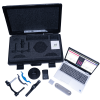It’s Time to Grow Your Clinic – New Referral Sources
Practice Management
Creating new referral sources is about building enough trust in you and your clinic for a prospective referral source (someone who doesn’t know you or your clinic), to give you and your clinic a try with one of their patients. Once you have maximized your patient share from your existing referral sources, it’s time to build these new relationships. Fortunately, the work that you did to maximize your patient share from existing sources can be used in developing new referral relationships. (Note: If you have not read “It’s Time to Grow your Clinic – Current Referral Sources,” I recommend you do so now.)
The absolute key to building trust with a new prospect in this circumstance is making the process about them, not about you. Think about this from your perspective. When a sales person leaves you a voice message or sends you an e-mail that speaks exclusively about them and their company and their product with no thought whatsoever about you, your clinic, and your problems, what is your reaction? Delete.
Now consider the sales person that demonstrates in a voice message or e-mail that they have done some research on your clinic, understood your circumstances, and have a potential solution that might be of value to you. Because they have made it about you, aren’t you more inclined to at least to engage with them in a brief conversation? Yes.
Let’s go even further, how often do you experience the latter approach. If your experience is like mine, the answer is not very often. How refreshing and stunning is it when a sales person demonstrates a genuine interest in you and, at the very least, a rudimentary knowledge of your situation? Very.
It’s worth repeating. The key to creating new referral relationships is making it about the prospect not about you.
Assuming you’ve done the work of how you and your clinic embody excellence and have built your brand promise, the starting point for creating new referral relationships is identifying prospects that you can genuinely create value for in the form of doing a better job of treating their patients. That is, who is not referring patients to you now that ought to because of your ability to achieve great clinical outcomes for them.
Undoubtedly, you are aware of referral sources in your area that are not sending patients to you. Make that list. Once you have the list, you should sort it on two dimensions. The first dimension is, of course, which sources have the largest number of patients that fit in your clinical sweet spot as articulated in your brand promise.
The second dimension is fuzzier. For the second dimension sort the list based on the attributes of the prospects. Specifically, think about the best relationships that you have with your current referring customers. What characterizes those relationships? How professional, congenial, informal, two-way, engaged, clinical, distant, etc. are they? With that picture in mind, rank the list with those prospects that look most like your current customers at the top. You want to target the prospects who most conduct themselves like your current customers and have a patient base that hits your clinical sweet spot. It will be easier for you to sell prospects you are comfortable with and, you want to “win” the opportunity to capture a considerable number of new patients.
Once you have your target list, I recommend you do something unconventional before you engage your sales approach. That is, go back to your very best referring customers and ask them if they would be willing to write a testimonial letter for you and your clinic. You are looking for a letter from them that articulates in detail how well you treat their patients, from patient experience through clinical outcomes. When you make this request, be very clear that you intend to use it to grow your practice and explain that the benefit to your customer in helping you with this is that it enhances your ability to continue to treat their patients with the level of excellence that they have come to expect from you. You can’t deliver excellence with a static clinic.
Testimonials are a powerful sales tool. Because a testimonial does not come from you, but rather an independent source, they are believed at face value. Prospects recognize that other people will not lie for you in a testimonial. They are accepted as valid representations of how good you are at what you do. Testimonials can simultaneously open the door for you and reduce the skepticism that a new prospect will inherently have about your representation of your skills and service offering. Get as many of these as you can.
While you are getting your testimonials together, conduct research on your targeted prospects. Review their websites, consider the location of their practice, look at the hospitals they are affiliated with, and consider your competitors that they are currently using. Your goal is to develop your best guess about what they are currently experiencing from your competitors and how you can do better. With this picture in mind and your testimonials in hand engage professional, honest, and forthright sales approach I’ve outlined in the past.
Write a business letter to the doctors from whom you intend to ask for business. In the letter –
- Make it clear that you have done some research on their practice.
- State that based on your research, you think there might be an excellent fit between the specific patients they treat and the specific therapies you provide.
- Ask for a meeting to confirm and correct this understanding and make a mutual determination on the value of them referring patients to you.
- Point them toward the testimonial(s) you have included as independent proof of the skill of you and your clinicians.
- Indicate when you will follow up to set up the meeting.
You will have to follow up a few times to set up the meeting. However, if you’ve made an intriguing case, it is likely that the practice will want to take the meeting you propose to insure the care their patients are receiving is as good as they want it to be.
The last step is to hold the meeting and work through the “agenda” you presented in the letter. Be professional, honest, and forthright. State your case and confirm and correct if you have it right. Point to the testimonial that you provided and ask what additional information the prospect would like about you and your clinic. Once you have answered all the questions that they have, and it’s been made clear in the conversation that the prospect sees value in working with you and your clinic, it’s time to ask for the opportunity to work with them. You must ask them. You might say something like the following.
“From what we’ve discussed, you like the approach we have for treating ACL patients. I suggest as a next step, you refer one of your ACL patients to us so that we can tangibly demonstrate how good we are with these patients. Does that make sense to you?”
Then wait for the answer. It will seem like an eternity. But, you must wait for the “yes” or the “no.”
If the answer is yes, work through how to arrange the first referral. If the answer is no, then you must find out where your proposal fell short. Simple ask what you missed and make sure you ask the clarifying questions you can to understand how you missed the mark. DO NOT attempt to get to yes at this time. Circle back with a thoughtful written reply and attempt to address the concerns that you uncovered.
Winning referrals from a new source will not be easy. The approach I’ve outlined above will work and if you’ve developed your sales skills by seeking additional referrals from your existing customers, you’ll be as ready as you’ll ever be. Remember to make the process about your prospect. If you take the approach that you want what is best for them and their patients, you will always be on solid ground.
